|
|
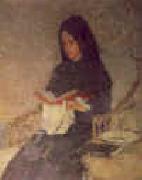 |
Gwen John
|
|
Welsh
1876-1939
Gwen John was born in Haverfordwest, Wales, the second of four children of Edwin William John and his wife Augusta (nee Smith). Edwin John was a solicitor whose dour temperament cast a chill over his family, and Augusta was often absent from the children due to ill health, leaving her two sisters??stern Salvationists??to take her place in the household. Despite the considerable tension in the family (who became known as "those turbulent Johns") the children's interest in literature and art was encouraged. Following the mother??s premature death in 1884, the family moved to Tenby in Pembrokeshire, Wales.
Although she painted and drew from an early age, her earliest surviving work dates from her nineteenth year. From 1895?C98, she studied at the Slade School of Art, where her younger brother, Augustus John, had begun his studies in 1894. During this period they shared living quarters, and further reduced their expenses by subsisting on a diet of nuts and fruit. Even as a student, Augustus' brilliant draughtsmanship and personal glamour made him a celebrity, and stood in contrast to Gwen's quieter gifts and reticent demeanour. While he greatly admired her art, Augustus offered her advice which she ignored; he urged her to take a "more athletic attitude to life", and cautioned her against what he saw as the "unbecoming and unhygienic negligence" of her mode of living, but her entire life was marked by a disregard for her physical well-being. In 1898 she made her first visit to Paris with two friends from the Slade, and while there she studied under James McNeill Whistler at the Academie Carmen. She returned to London in 1899, and spent the next four years in austere circumstances. When she exhibited her work for the first time in 1900, at the New English Art Club (NEAC), her address was a derelict building where she was living illegally. |
|
|
|
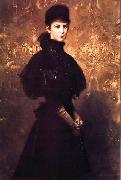 |
Gyula Benczur
|
|
Gyula Benczur (1844 - 1920) was a Hungarian painter and pedagogue. He won international success with his first few paintings, winning several competitions. He assisted Karl von Piloty with the frescoes of Maximilianeum and Rathaus in Munich. He also illustrated books by the great German writer, Friedrich Schiller. He was commissioned by the Bavarian king Ludwig II to paint Rococo themes. Later he was offered numerous international teaching positions, including offers in Prague and Weimar, but accepted a position in Munich, one of his most distinguished pupils being the Swiss-born American painter Adolfo Meller-Ury. Benczur was later a favorite among the Hungarian upper-class, painting numerous portraits of kings and aristocrats. He was considered a rival in historical painting to Makart. During his lifetime, Benczur won numerous awards. His self-portrait is on display at the Uffizi Gallery in Florence. |
|
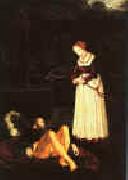 |
Hans Baldung Grien
|
|
German
1485-1545
Hans Baldung Grien Galleries
The earliest pictures assigned to him by some are altar-pieces with the monogram H. B. interlaced, and the date of 1496, in the monastery chapel of Lichtenthal near Baden-Baden. Another early work is a portrait of the emperor Maximilian, drawn in 1501 on a leaf of a sketch-book now in the print-room at Karlsruhe. "The Martyrdom of St Sebastian and the Epiphany" (Berlin Museum), fruits of his labour in 1507, were painted for the market-church of Halle in Saxony.
Baldung's prints, though D??reresque, are very individual in style, and often in subject. They show little direct Italian influence. His paintings are less important than his prints. He worked mainly in woodcut, although he made six engravings, one very fine. He joined in the fashion for chiaroscuro woodcuts, adding a tone block to a woodcut of 1510.[1] Most of his hundreds of woodcuts were commissioned for books, as was usual at the time; his "single-leaf" woodcuts (ie prints not for book illustration) are fewer than 100, though no two catalogues agree as to the exact number.
He was extremely interested in witches and made many images of them in different media, including several very beautiful drawings finished with bodycolour, which are more erotic than his treatments in other techniques.
Witch and Dragon. Drawing with bodycolour (b/w repro)Without absolute correctness as a draughtsman, his conception of human form is often very unpleasant, whilst a questionable taste is shown in ornament equally profuse and baroque. Nothing is more remarkable in his pictures than the pug-like shape of the faces, unless we except the coarseness of the extremities. No trace is apparent of any feeling for atmosphere or light and shade. Though Gr??n has been commonly called the Correggio of the north, his compositions are a curious medley of glaring and heterogeneous colours, in which pure black is contrasted with pale yellow, dirty grey, impure red and glowing green. Flesh is a mere glaze under which the features are indicated by lines. (1911)
His works are mainly interesting because of the wild and fantastic strength which some of them display. His Eve, the Serpent and Death (National Museum of Canada) shows his strengths well. We may pass lightly over the "Epiphany" of 1507, the "Crucifixion" of 1512, or the "Stoning of Stephen" of 1522, in the Berlin Museum. There is some force in the "Dance of Death" of 1517, in the museum of Basel, or the Madonna of 1530, in the Liechtenstein Gallery at Vienna. Gr??n's best effort is the altarpiece of Freiburg, where the Coronation of the Virgin, and the Twelve Apostles, the Annunciation, Visitation, Nativity and Flight into Egypt, and the Crucifixion, with portraits of donors, are executed with some of that fanciful power which Martin Schongauer bequeathed to the Swabian school.
As a portrait painter he is well known. He drew the likeness of Charles V, as well as that of Maximilian; and his bust of Margrave Philip in the Munich Gallery tells us that he was connected with the reigning family of Baden, as early as 1514. At a later period he had sittings from Margrave Christopher of Baden, Ottilia his wife, and all their children, and the picture containing these portraits is still in the grand-ducal gallery at Karlsruhe. Like D??rer and Cranach, Gr??n became a hearty supporter of the Reformation. He was present at the diet of Augsburg in 1518, and one of his woodcuts represents Luther under the protection of the Holy Ghost, which hovers over him in the shape of a dove. |
|
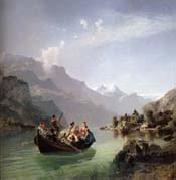 |
Hans Gude
|
|
March 13, 1825 ?C August 17, 1903,Norwegian painter. He was the most renowned Norwegian landscape painter of his time. At the age of 12 he was enrolled as a pupil of Johannes Flintoe (1787-1880). After attending evening classes at the Kongelige Tegneskole in Christiania, he went to D?sseldorf in 1841 to study privately with the landscape painter Andreas Achenbach (1815-1910). In 1842 Gude was admitted to the landscape class at the Akademie under Johann Wilhelm Schirmer. He was later appointed an assistant teacher at Schirmer private studio, and he succeeded his master as Professor of landscape painting both at the D?sseldorf Akademie (1854-62) and at the Karlsruhe Akademie (1864-80). In the 1840s Gude established his reputation in Norway and on the Continent with powerful images of the Norwegian mountains. These were shown in the Kunstforening galleries in D?sseldorf and Christiania and at the Berliner Akademische Kunstausstellung, where Gude exhibited throughout his life. Adolph Tidemand and Gude dominated the colony of Norwegian artists who studied in D?sseldorf in the mid-19th century. The two artists worked together on five paintings, all representing people in boats; Gude painted the landscape, Tidemand the figures. The Bridal Procession at Hardanger (1848; Oslo, N.G.) celebrates a ceremony of country life and is the most famous work of Norwegian National Romanticism. In a sunny western Norwegian landscape with snow on the high mountains, the bridal couple and wedding guests in national costume are shown rowing across the water from a medieval stave church on the headland in the background. Gude revealed greater maturity in High Mountain (1857; Oslo, N.G.). The disposition of mountains massed on the high plateau around a little lake produces an effect of monumentality. The predominant colours shade from grey to blue, concentrated in the cloud cover. The influence of Schirmer tranquil landscapes is apparent, while the rhythmic arrangement of light and shadow is reminiscent of Achenbach. |
|
 |
Harold Gilman
|
|
British
1878-1919
Harold Gilman Gallery
Developing an interest in art during a childhood convalescence period, he began his artistic training after a non-collegiate year at Oxford University (again cut short by ill health) and time working as a tutor to an English family living in Odessa. Studying at the Hastings School of Art (1896) and then the Slade School of Fine Art (1897?C1901), he then spent over a year studying the Spanish masters (Velazquez as well as Whistler were major early influences) and meeting and marrying the American painter Grace Cornelia Canedy. Moving back to London, where they settled (apart from an abortive trip to visit her family in Chicago, in which Gilman ducked pressure to join the Canedy family business), they had two daughters (one in London, one in Chicago).
Meeting Walter Sickert in 1907, Gilman became a founder member of both the Fitzroy Street Group (in 1907) and the Camden Town Group (in 1911). In the meantime he joined the Allied Artists' Association, moved to Letchworth, and began to show influence from work of Vuillard as well as Sickert. He soon outpaced Sickert's understanding of post-Impressionism and moved out from under his shadow, however, using ever stronger colour and identifying with Charles Ginner as a 'Neo-Realist' (exhibiting with Ginner under that label in 1914).
Canal Bridge, Flekkefjord, c. 1913Gilman visited Scandinavia in 1912 and 1913, and may have travelled with the artist William Ratcliffe, who had relations there. Gilman made studies of the environment, and painted Canal Bridge, Flekkefjord, an accurate depiction, whose subject is likely to have been inspired by Vincent van Gogh's depiction of a similar bridge in Provence. Gilman had rejected Van Gogh's work when he first encountered it, but later became a strong admirer and, according to Wyndham Lewis, keeping postcards of Van Gogh's work on his wall and sometimes hanging one of his own works next to them, if he was especially satisfied with it.
At that time he also joined Robert Bevan's short-lived Cumberland Market Group with Ginner and John Nash. Remarrying in 1917, in 1918 he was commissioned to travel to Nova Scotia by the Canadian War Records. |
|
 |
Harold Gilman
|
|
(11 February 1876 - 12 February 1919) was a painter of interiors, portraits and landscapes, and a founder-member of the Camden Town Group.
Though born in Rode, Somerset, Gilman spent his early years at Snargate Rectory, in the Romney Marshes in Kent, where his father was the Rector. He was educated in Kent at Abingdon, Rochester and Tonbridge schools, and for one year at Brasenose College in Oxford University.
Although he developed an interest in art during a childhood convalescence period, Gilman did not begin his artistic training until after his non-collegiate year at Oxford University (cut short by ill health) and after working in the Ukraine as a tutor to a British family in Odessa (1895). In 1896 he entered the Hastings School of Art to study painting, but in 1897 transferred to the Slade School of Fine Art in London, where he remained from 1897 to 1901, and where he met Spencer Gore. In 1904 he went to Spain and spent over a year studying Spanish masters (Velezquez and Goya as well as Whistler were major early influences).
At this time he met and married the American painter Grace Cornelia Canedy. The couple settled in London (apart from a visit to her family in Chicago, when Gilman ducked pressure to join the Canedy family business). They had two daughters (one in London, one in Chicago).
|
|
|
|
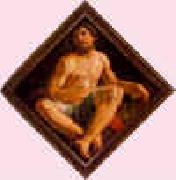 |
Hendrick Goltzius
|
|
1558-1617 Dutch
Hendrik Goltzius (1558 - January 1, 1617), Dutch printmaker, draftsman, and painter, was born at Millebrecht, in the duchy of Julich. He was the leading Dutch engraver of the early Baroque period, noted for his sophisticated technique.
After studying painting on glass for some years under his father, he was taught the use of the burin by Dirk Volkertszoon Coornhert, a Dutch engraver of mediocre attainment, whom he soon surpassed, but who retained his services for his own advantage. He was also employed by Philip Galle to engrave a set of prints of the history of Lucretia.
At the age of 21 he married a widow somewhat advanced in years, whose money enabled him to establish at Haarlem an independent business; but his unpleasant relations with her so affected his health that he found it advisable in 1590 to make a tour through Germany to Italy, where he acquired an intense admiration for the works of Michelangelo, which led him to emulate that master in the grotesqueness and extravagance of his designs. He returned to Haarlem considerably improved in health, and laboured there at his art till his death.
Goltzius' painting Lot and his daughters (Rijksmuseum Amsterdam) shows Lot being seduced by his two daughters. Sodom and Gomorrah are shown burning in the background, with Lot's wife who had turned into a pillar of salt, in front.Goltzius ought not to be judged chiefly by the works he valued most, his eccentric imitations of Michelangelo. His portraits, though mostly miniatures, are masterpieces of their kind, both on account of their exquisite finish, and as fine studies of individual character. Of his larger heads, the life-size portrait of himself is probably the most striking example. His masterpieces, so called from their being attempts to imitate the style of the old masters, have perhaps been overpraised.
Goltzius brought to an unprecedented level the use of the "swelling line", where the burin is manipulated to make lines thicker or thinner to create a tonal effect from a distance. He also was a pioneer of "dot and lozenge" technique, where dots are placed in the middle of lozenge shaped spaces created by cross-hatching to further refine tonal shading.
A self portraitHollstein credits 388 prints to him, with a further 574 by other printmakers after his designs.
In his command of the burin Goltzius is said to rival that of Durer's; but his technical skill is not equally aided by higher artistic qualities. Even, however, his eccentricities and extravagances are greatly counterbalanced by the beauty and freedom of his execution. He made engravings of Bartholomeus Spranger's paintings, thus increasing the fame of the latter - and his own. Goltzius began painting at the age of forty-two; some of his paintings can be found in the imperial collection at Vienna. He also executed a few chiaroscuro woodcuts. He was the stepfather of engraver Jacob Matham. |
|
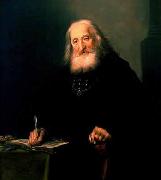 |
Hendrik Gerritsz. Pot
|
|
(c. 1580 - 15 October 1657 (buried)) was a Dutch painter. He lived and painted in Haarlem, where he was an officer of the militia, or schutterij. Dutch artist Frans Hals painted Pot in militia sash in Hals' The Banquet of the Officers of the St George Militia Company (c. 1639). Pot is the man reading a book on the far right.
Pot was born in Amsterdam and spent his early years in Amsterdam and Haarlem. In 1632 he traveled to London, where he painted the Royal Family. He lived from 1633 to 1648 in Haarlem, after which he moved to Amsterdam, where he died in 1657.. He served as Dean of the Haarlem Guild of St. Luke in 1626, 1630 and 1635. He served as the Guild's headman or Hoofdman in 1634 and 1648. He died in Amsterdam. |
|
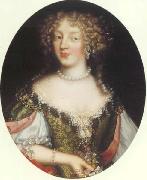 |
Henri Gascar
|
|
Henri Gascar, Portrait of Barbara Palmer, 1st Duchess of Cleveland
James II of England, then Duke of York (1660s)Henri Gascar (1635 -1 Jan 1701) was a French-born portrait painter who achieved artistic success in England during the reign of Charles II. He painted many leading ladies at court, including several of the King's mistresses.
Gascar was born in Paris, the son of Pierre Gascar, a minor painter and sculptor. Gascar came to England about 1674, probably at the behest of Louise de Keroualle, Duchess of Portsmouth, Charles II's favourite mistress. Gascar (or Gascard, as he seems to have spelt his name at first) was already known as a skillful portrait-painter; among the portraits already painted by him was that of Nicolas de Lafond, author of the "Gazette of Holland", painted in 1667, and engraved by Peter Lombart.
The patronage of the Duchess of Portsmouth insured Gascar a rapid success in England. His flamboyant style, contrasting with the stolid English approach, seemed to suit the frivolity of the time and he painted many of the ladies of Charles II's court. His lack of attention to detail in the likeness he made up for by the sumptuous draperies and tawdry adornments around the subject. For a short time he became fashionable, and is said to have amassed a fortune of over £10,000.
Among the portraits painted by him during his time in England were Charles II (engraved by Peter Vanderbank); Louise, Duchess of Portsmouth (twice - once engraved by Étienne Baudet); Barbara, Duchess of Cleveland (nee Villiers), and her daughter, Barbara Fitzroy; Charles Lennox, 1st Duke of Richmond; Frances Stewart, Duchess of Richmond; George FitzRoy, 1st Duke of Northumberland; Nell Gwyn; Sophia Bulkeley (engraved by Robert Dunkarton); Edmund Verney; and Philip Herbert, 7th Earl of Pembroke. It is stated that the last-named portrait was done surreptitiously for Louise, Duchess of Portsmouth. A portrait by Gascar of James II as Duke of York was in that king's collection. |
|
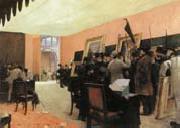 |
Henri Gervex
|
|
French Academic Painter, 1852-1929.French painter. His artistic education began with the Prix de Rome winner Pierre Brisset (1810-90). He then studied under Alexandre Cabanel at the Ecole des Beaux-Arts in Paris, where his fellow pupils included Henri Regnault, Bastien-Lepage, Forain, Humbert (1842-1934) and Cormon; and also informally with Fromentin. Gervexs first Salon picture was a Sleeping Bather (untraced) in 1873: the nude, both in modern and mythological settings, was to remain one of his central artistic preoccupations. In 1876 he painted Autopsy in the H?tel-Dieu (ex-Limoges; untraced), the sort of medical group portrait he repeated in 1887 with his Dr Pean Demonstrating at the Saint-Louis Hospital his Discovery of the Hemostatic Clamp (Paris, Mus. Assist. Pub.), which celebrated the progress of medical science with a sober, quasi-photographic realism. Gervexs most controversial picture was Rolla (1878; Bordeaux, Mus. B.-A.), refused by the Salon of 1878 on grounds of indecency, partly because of the cast-off corset Degas had insisted he include. The painting shows the central character in a de Musset poem, Jacques Rolla, who, having dissipated his family inheritance, casts a final glance at the lovely sleeping form of the prostitute Marion before hurling himself out of the window. As his friend, Manet, had done the year before with his rejected Nana (1877; Hamburg, Ksthalle), Gervex exhibited his work in a commercial gallery, with great success. |
|
|
|
|
|
 |
Henry de Groux
|
|
Belgian
1867-1930
Henry de Groux (1866 in Brussels - 1930 in Marseilles) was a Belgian Symbolist painter, sculptor and lithographer. His 1889 painting Christ aux Outrages, widely described as his masterwork, depicted Jesus being attacked by a mob. Later in life, he produced many works depicting the horrors of the First World War.
Ride of the Valkyries (ca. 1890)
Royal Museums of Fine Arts, Brussels, BelgiumDe Groux was a member of les XX, but was expelled when he refused to have his works displayed in the same gallery as Vincent van Gogh. He subsequently moved to Paris, where he befriended Emile Zola; during the social unrest resulting from the Dreyfus affair, de Groux acted as one of Zola's bodyguards.
As well, de Groux was a fervent diarist; beginning in 1892, he produced 18 volumes detailing the life of a European artist in the late 19th and early 20th centuries. In 2002, his descendants donated these volumes to the Institut national d'histoire de l'art; selected excerpts were published in 2007 Henry de Groux 1866-1930 - journal - Henry De Groux, Rodolphe Rapetti, Pierre Wat - Editions Kime. |
|
|
|
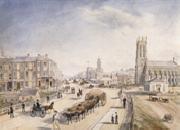 |
Henry Gritten
|
|
Australian Landscape artist
1818-1873
was an English/Australian artist. Gritten was the son of a London picture dealer, was born probably in 1817. He studied art and was on friendly terms with David Roberts and other leading artists of the period. He began exhibiting at the Royal Academy in 1835, and during the next 10 years 12 of his pictures were hung at its exhibitions. He was a more frequent exhibitor at the British Institution, and had 30 of his pictures hung there between 1836 and 1848. In the latter year he went to the United States and in about 1852 arrived in Australia. He went first to the Bendigo goldfields, but soon resumed painting in Victoria and Tasmania; there is a View of Hobart in 1857 by him at the National Library of Australia at Canberra. He was represented at the first exhibition of the Victorian Academy of Art held at Melbourne in 1870. He died suddenly at Melbourne leaving a widow and four children in poor circumstances. Gritten was quite a capable painter of his period who had a hard struggle in Australia. |
|
|
|
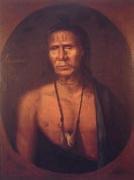 |
Hesselius Gustavus
|
|
American portrait painter.
1682-1755
He was trained in Sweden as a wood-engraver, gilder and painter. In 1712 he accompanied his brother, a Lutheran pastor, to America, where he settled in Philadelphia, PA. About 1720 he moved to the Annapolis, MD, area, returning before 1730 to Philadelphia, where he lived until his death. He was one of the first European-trained painters to settle permanently in America and introduced a greater technical skill and increased realism into Colonial painting. His painterly, atmospheric style, which derived from European Baroque, contrasted with the more linear technique of American-born painters. During most of his career he was the leading painter of the Middle Colonies. In addition to mythological scenes, altarpieces and portraits of prominent individuals, Hesselius undertook utilitarian work that included painting the country seat at Springettsbury of Thomas Penn (1702-75) and the interior of the Pennsylvania State House, as well as flower-boxes, |
|
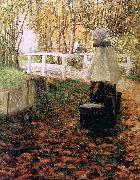 |
Hitchcock, George
|
|
American Painter, 1850-1913
American painter, active in the Netherlands. A descendant of Roger Williams (the founder of Rhode Island), he practised law for several years in New York before deciding in 1879 to become an artist. He studied in Paris with Gustave Boulanger and Jules Lefebvre, in D?sseldorf, and in The Hague with H. W. Mesdag. He settled in Egmond-aan-Zee, near Alkmaar, in 1883, and was soon widely known for his paintings of religious subjects in contemporary settings and of sunlit views of tulip fields. He returned to the USA only occasionally in later years. Hitchcock's style, similar to Impressionism, has been appreciated more in Europe than in the USA. A good example of his style is the Blessed Mother (1892; Cleveland, OH, Mus. A.). He received some recognition in the USA, such as election to associate membership in the National Academy of Design, New York, |
|
|
|
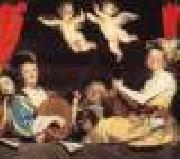 |
HONTHORST, Gerrit van
|
|
Dutch Baroque Era Painter, ca.1590-1656
Dutch portrait, genre, and allegorical painter. In Italy (c.1610?C1620) he gained a sound understanding of the works of Caravaggio, which greatly affected his style. He was a master at painting candlelit genre pieces and biblical scenes. Upon his return to Holland, he introduced the Italian manner of illusionistic decoration into Dutch interiors, as in his decorative scheme for the palace of Honselaarsdijk. In 1628, Charles I invited him to England, where he decorated Whitehall and painted portraits of the king and nobility. Several of these are now in the National Gallery, London. He also worked for the court of Denmark, and from 1637 to 1652 at The Hague. Together with Terbrugghen and Baburen he led the influential Utrecht school of painting that introduced Caravaggesque dramatic realism into Dutch art. |
|
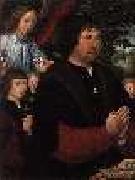 |
HORENBOUT, Gerard
|
|
Flemish Northern Renaissance Painter and Manuscript Illuminator, ca.1465-1541
Painter, designer, scribe and cartographer. He may have been the pupil of Li?vin de Stoevere ( fl 1463), the only painter of the five artists who guaranteed his admission fee into the guild of painters and illuminators in Ghent in 1487. Horenbout became a versatile and productive artist, painting altarpieces, portraits and illuminated manuscripts and designing tapestries and stained-glass windows. He also collaborated with the nuns of the convent of Galilee near Ghent in making a model garden with flowers made of cloth that he delivered to Margaret of Austria, Regent of the Netherlands, at her court in Mechelen. He seems to have achieved a degree of wealth commensurate with his output: in 1503 he acquired a house |
|
|
|
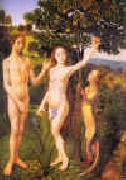 |
Hugo van der Goes
|
|
1440-1482
Flemish
Hugo van der Goes Galleries
Hugo became a member of the painters' guild of Ghent as a master in 1467. In 1468 he was involved in the decoration of the town of Bruges in celebration of the marriage between Charles the Bold and Margaret of York and he provided heraldic decorations for Charles's joyeuse entr??e to Ghent in 1469 and again in 1472. He was elected dean of the Ghent guild in 1473 or 1474.
In 1475, or some years later, Hugo entered Rooklooster, a monastery near Brussels belonging to the Windesheim Congregation, and professed there as a frater conversus. He continued to paint, and remained at Rooklooster until his death in 1482 or 1483. In 1480 he was called to the town of Leuven to evaluate the Justice Scenes left unfinished by the painter Dieric Bouts on his death in 1475. Shortly after this, Hugo, returning with other members of his monastery from a trip to Cologne, fell into a state of suicidal gloom, declaring himself to be damned. After returning to Rooklooster, Hugo recovered from his illness, and died there. His time at Rooklooster is recorded in the chronicle of his fellow monk, Gaspar Ofhuys. A report by a German physician, Hieronymus M??nzer, from 1495, according to which a painter from Ghent was driven to melancholy by the attempt to equal the Ghent Altarpiece, may refer to Hugo.
His most famous surviving work is the Portinari Triptych (Uffizi, Florence), an altarpiece commissioned for the church of San Egidio in the hospital of Santa Maria Nuova in Florence by Tommaso Portinari, the manager of the Bruges branch of the Medici Bank. The triptych arrived in Florence in 1483, apparently some years after its completion by van der Goes. The largest Netherlandish work that could be seen in Florence, it was greatly praised. Giorgio Vasari in his Vite of 1550 referred to it as by "Ugo d'Anversa" ("Hugo of Antwerp"). This the sole documentation for its authorship by Hugo; other works are attributed to him based on stylistic comparison with the altarpiece.
Hugo appears to have left a large number of drawings, and either from these or the paintings themselves followers made large numbers of copies of compositions that have not survived from his own hand. A drawing of Jacob and Rachel preserved at Christ Church, Oxford is thought to be a rare surviving autograph drawing. |
|
|
|
|
|
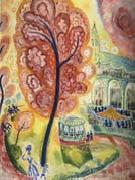 |
Isaac Grunewald
|
|
Swedish, 1889-1946,was a Swedish-Jewish Expressionist painter born in Stockholm. Having studied at a Swedish art school, at age nineteen Gr??newald travelled to Paris to study under Henri Matisse. In 1909 he gained recognition in his homeland when he exhibited his work at Halldins konsthandel. He met Fauvist painter Sigrid Hjert??n, who had studied at the College of Crafts and Design in Stockholm, and encouraged her to return with him to study in Paris. Married in 1911, they became part of a group of Scandinavian artists known as "De Unga" (The Young Ones). The Crane (1915) by Isaac GrunewaldGrenewald and Hjerten regularly exhibited together at home and abroad and art historians now often cite them as being responsible for introducing modernism to Sweden. At a time in history when anti-Semitism was widespread and women in art were frowned upon, although widely known they were never fully accepted by the artistic community of the day and their works were often the subject of ridicule. Partly as a result of this, Isaac Grunewald had to supplement his income creating stage designs for the Royal Dramatic Theatre and the Royal Swedish Opera. He decorated the walls and ceiling of an auditorium (since renamed Grunewald Hall) at the Stockholm Concert Hall, site of the Nobel Prize ceremony, and the walls of the Matchstick Palace. The author of numerous essays on art, with his 1918 exhibit at Stockholm's Liljevalchs Konsthall Isaac Grunewald published his manifesto on Expressionism and opened his own art school. During the Second World War Grunewald worked at the renowned Rorstrand porcelain factory. His wife Sigrid Hjerten suffered from lifelong mental health problems frequently evidenced by anxiety and paranoia that resulted in her being hospitalized for extended periods in the 1930s. During the marriage the couple were frequently apart from each other for long periods and they separated permanently in 1937 and soon divorced. Isaac Grunewald remarried and in 1946 both he and his second wife were killed in an airplane crash. He is buried in Stockholm's Norra begravningsplatsen ("Northern Cemetery"). His 1912 self-portrait and his 1915 painting "The Singing Tree" appeared on Swedish postage stamps. Today, institutions such as the Arken Museum of Modern Art in Ishoj, Denmark rank Grunewald and Hjerten among the 20th Century's most important Scandinavian artists. |
|
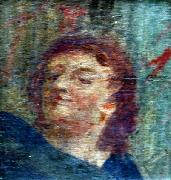 |
Ivan Grohar
|
|
Ivan Grohar (15 June 1867 - 19 April 1911) was a Slovene Impressionist painter. Together with Rihard Jakopič, Matej Sternen and Matija Jama, he is considered one of the leading figures of Slovene impressionism in the fin de siecle period.
Grohar was born in the Upper Carniolan village of Spodnja Sorica, then part of the Austro-Hungarian Empire. From an early age, he showed an interest in art but he could not develop his talent because he was an orphan and lived in poverty. In 1888, the local vicar Anton Jamnik sent him to an exhibition in the nearby town of Škofja Loka, enabling him to spend the summer working in the town of Kranj under the supervision of the church painter Matija Bradaška. He also travelled to Zagreb, where he worked in the atelier of Spiridion Milanesi, until he was conscripted into the Austro-Hungarian Army. He disliked the military life, so he deserted and fled to Venice, in Italy. Left with nothing, he appealed to the Austro-Hungarian consulate. In 1889 a court sentenced him to a short stay in prison and extended his military service by one year.
Ivan Grohar: Brna from 1899In 1892, he applied to the Carniolan Provincial Diet for financial assistance to study at the Graz school of painting, which he received. Two years later, he applied for assistance to study at the Academy of Fine Arts in Vienna. This assistance was also approved, but despite his excellent exam result, he was not accepted to the Academy because he had not finished his studies in Graz. He continued his schooling in Graz and finished it at the end of 1894. In August 1896, he opened his own atelier in Škofja Loka. He also worked in Munich, where he attended Anton Ažbe school of art. Back home, he befriended the impressionist painter Rihard Jakopič. In autumn of 1900, he took part in the first Slovene Artistse Exhibition, organised by the Slovene Artistic Association (Slovensko umetniško društvo, SUD). He was elected to the position of treasurer of the SUD, but illegally borrowed money from the association, for which he was sentenced to three monthse imprisonment. On his release, he left for Vienna. |
|
 |
J B Armand Guillaumin
|
|
1841-1927
Born Jean-Baptiste Armand Guillaumin in Paris, France, he worked at his uncle's lingerie shop while attending evening drawing lessons. He also worked for a French government railway before studying at the Academie Suisse in 1861. There, he met Paul C??zanne and Camille Pissarro with whom maintained lifelong friendships. While he never achieved the stature of these two, his influence on their work was significant. C??zanne attempted his first etching based on Guillaumin paintings of barges on the River Seine.
Guillaumin exhibited at the Salon des Refus??s in 1863 and later became a friend of Vincent van Gogh whose brother, Theo sold some of his works.
Noted for his intense colors, major museums around the world display Guillaumin's art. He is best remembered for his landscapes of Paris, the Creuse departement, and the area around Les Adrets-de-l'Esterel near the Mediterraneran coast in the Provence-Alpes-Cote d'Azur region of France.
Armand Guillaumin died in 1927 in Orly, Val-de-Marne just south of Paris. |
|
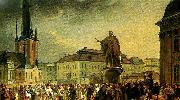 |
j. g. sandberg
|
|
Johan Gustaf Sandberg, född 1782, död 1854, var målare; han var professor i teckning vid Konstakademien från 1828, och direktör där 1845?C1853.
Sandberg ägnade sig främst åt historiemåleri, med motiv ur nordisk mytologi och svensk historia. Hans främsta verk inom detta område är kalkmålningarna över Gustav Vasa i Uppsala domkyrka. Han målade också en mängd porträtt.
Efter akademiska studier i Åbo med början 1783, och Uppsala, dit han flyttade 1788, blev han filosofie magister 1791. Han blev 1792 extra ordinarie kanslist i akademiska kansliet. Juris utriusque kandidat blev han 1792 och kort därefter docent vid juridiska fakulteten, blev juris licentiat 1800 och utnämndes 1807 till jurisprudentiä, oeconomiæ et commerciorum professor i Uppsala. Juris utriusque doktor 1810; arbetande ledamot i Lagkommissionen 1811-1814; ledamot av Krigsvetenskapsakademien 1810, Lantbruksakademien 1812, Vetenskapssocieteten i Uppsala 1829 samt flera andra lärda samfund. År 1834 erhöll han adlig värdighet och tog avsked från sin professur 1837. Lars Rabenius ligger begravd på Uppsala gamla kyrkogård. |
|
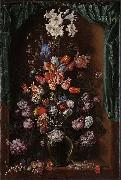 |
Jacob de Gheyn II
|
|
Jacob de Gheyn II (also Jacques de Gheyn II) (c. 1565, Antwerp - March 29, 1629, The Hague) was a Dutch painter and engraver, whose work shows the transition from Northern Mannerism to Dutch realism over the course of his career.
|
|
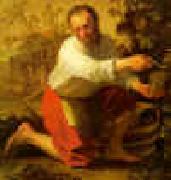 |
Jacob Gerritsz Cuyp
|
|
1594-1652
Dutch
Jacob Gerritsz Cuyp Locations
Painter and draughtsman. Probably taught by his father, he entered the Guild of St Luke in Dordrecht in 1617, the same year that he executed an important commission to portray the masters of the Holland Mint (Dordrecht, Mus. van Gijn). He was the Guild bookkeeper in 1629, 1633, 1637 and 1641 and, according to Houbraken, led Dordrecht fine painters in their separation from the Guild in 1642. Jacob married Aertken van Cooten from Utrecht in 1618; his only child, (3) Aelbert Cuyp, was born two years later. |
|
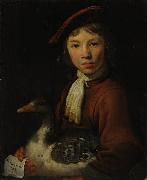 |
Jacob Gerritsz. Cuyp
|
|
was a portrait and landscape painter. He was born and died in Dordrecht, and was the half-brother of Benjamin Gerritsz Cuyp and the father of the much more famous Aelbert Cuyp.
According to Houbraken, he helped the painters Jacques de Claeuw, Isaac van Hasselt, and Cornelis Tegelberg set up a Guild of Saint Luke in Dordrecht in 1642.
|
|
|
|
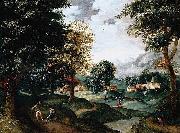 |
Jacob Grimmer
|
|
(ca. 1526-1590) was a Flemish Renaissance landscape painter.
Grimmer was born and died in Antwerp. According to Karel van Mander he first learned to paint landscapes from Matthys Cock and later from Christiaen Queburgh, both of Antwerp. He was a very skilled painter of houses, sky, and foreground views. He was a member of the Guild of St. Luke who was active as a rederijker and acted in many plays.
According to the RKD his earliest dated work is from 1546 and his latest dated work was 1589. Most of his works are landscapes and he worked together with Gillis Mostaert. Abel Grimmer was his son and pupil.
|
|
|
|
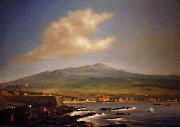 |
James Gay Sawkins
|
|
(1806-1878) was an artist who was born in 1806 in Yeovil, Somerset, England. At the age of 14, he moved to Baltimore, Maryland with his family, where he made his living painting miniature portraits on ivory. He lived in Cuba from 1835 to 1845 and visited Hawaii from January, 1850 to June, 1852. After working in Australia, he returned to England in 1855. Sawkins died in 1878 in Turnham Green (near London), England.
The Honolulu Academy of Arts, Mission House Museum (Honolulu, Hawaii) and the National Library of Australia (Canberra) are among the public collections holding works by James Gay Sawkins.
|
|
 |
James Gibbs
|
|
1682-1754
James Gibbs was born at Footdeesmire near Aberdeen, Scotland, in December 1682, the younger son of a Scottish gentleman. As a young man, he traveled on the Continent, pursuing his fondness for drawing. In Rome he determined to become an architect and entered the school of Carlo Fontana. Gibbs became acquainted with many members of the English aristocracy, for whom he made drawings and who were helpful to him in later life. He returned to England in 1709.
Through the influence of Edward Harley, Earl of Oxford, Gibbs was made one of the surveyors to the commissioners for building 50 new churches in London in 1713, and in this capacity he designed St. Mary-le-Strand (1714-1717), his first public building. Here he expressed not only influences of Sir Christopher Wren but also ideas absorbed from Italian baroque and mannerist architecture. Gibbs was employed by Lord Burlington in rebuilding the east block of Burlington House, Piccadilly, before that patron embraced Palladianism, but was superseded by the earl protege, Colen Campbell.
When the Whigs, who supported the Palladians, came to power, Gibbs as a Tory of baroque tendencies lost his official post in 1715, but his private practice among Tory patrons continued to be exclusive and remunerative. He built Cannons House, Middlesex (1716-1719; demolished 1747) for the Duke of Chandos; added a chapel and library at Wimpole Hall, Cambridgeshire (ca. 1720), for Lord Harley; built the exquisite Octagon Room at Twickenham, Middlesex (1720), with beautiful plasterwork by Italian stuccoworkers; and erected Ditchley House, Oxfordshire (1720-1725), probably his most splendid house, for the Earl of Lichfield, again with remarkable plasterwork by Italian craftsmen.
But public commissions were not entirely lacking. In 1720 Gibbs designed St. Martins-in-the-Fields (built 1722-1726), one of his outstandingly beautiful works. Like St. Mary-le-Strand and many of his houses, the interior was decorated with plasterwork by the fashionable Italian stuccoworkers, who probably came to England through his encouragement. St. Martins was followed by another building of extreme elegance and dignity, the Senate House at Cambridge (1722-1730), as well as the new buildings of King College. Many of the ornamental buildings in the park at Stowe House, Buckinghamshire, are his work, including the Temple of Diana (1726), the Temple of Friendship (1739), the Gothic Temple (1740), and the Column with a statue of Lord Cobham.
Gibbs general influence among architects and clients was great because of his exhaustive knowledge of architecture acquired through long study in Rome, an experience rare among architects of that generation, although later more common. This influence he extended by means of his Book of Architecture (1728), a record of both his executed and unexecuted work, and especially his Rules for Drawing the Several Parts of Architecture (1732), a work used by countless architects, students, scholars, and builders up to the present day.
Of Gibbs later works the circular Radcliffe Library at Oxford (1737-1749) is his most ambitious and monumental achievement; it shows much influence of Nicholas Hawksmoor. Gibbs published the designs in the large folio volume Bibliotheca Radcliviana in 1747, and he received from the university the honorary degree of master of arts. He designed the new decorations of Ragley Hall, Warwickshire (ca. 1750-1755), in the rococo taste then becoming fashionable. A distinguished late work is the church of St. Nicholas at Aberdeen (1751-1755). In his last years Gibbs held the sinecure post of architect to the Office of Ordnance. He died in London on Aug. 5, 1754.
In his early buildings, especially in his churches, Gibbs displayed that discreet form of the baroque which he had absorbed from Carlo Fontana in Rome and also from Wren example. Characteristic features of his work are window architraves interrupted by prominent rustication blocks, oeil de boeuf (oxeye) windows, boldly projecting cornices, and parapets topped by urns. In his later buildings the exterior form conformed more closely to severe Palladian principles, but the interiors retained a baroque exuberance. |
|
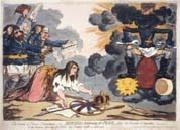 |
James Gillray
|
|
English Illustrator, 1757-1815
English caricaturist and illustrator. He was essentially self-trained although he studied at the Royal Academy and on the Continent. His caricatures of the court of George III made him immensely popular. His masterly delineations, vigorous, clever, often subtle, sometimes vulgar and grotesque, numbered more than 12,000. Among his best-known cartoons are A New Way to Pay the National Debt (1796), Social Elements in Skating (1805), |
|
|
|
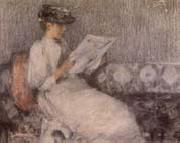 |
James Guthrie
|
|
Scottish Painter, 1859-1930
Sir James Guthrie (June 10 1859?CSeptember 6 1930) was a Scottish painter known, later on in his career, for his portraiture, although primarily known for his work in the realm of Scottish Realism.
Born in Greenock, Guthrie, the son of a clergyman, originally enrolled at Glasgow University to study law, but abandoned this in favour of painting in 1877. Unlike many of his contemporaries he did not study in Paris, being mostly self-taught, although he was mentored for a short time by James Drummond in Glasgow and then John Pettie in London. He lived most of his life in the Scottish Borders, most notably in Cockburnspath, Berwickshire, where he painted some of his most important works, including A Hind Daughter (1883), and Schoolmates. He was strongly influenced by the French Realists, especially Jules Bastien-Lepage, and was associated with the Glasgow Boys.
He was elected an associate of the Royal Scottish Academy in 1888, and a full member in 1892. In 1902 he succeeded Sir George Reid as RSA president in 1902, and he was knighted the following year. He died in Rhu, Dunbartonshire in 1930 |
|
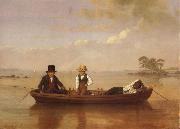 |
James-Goodwyn Clonney
|
|
British/American, 1812-1867, American painter. He was one of the first generation of American genre painters. His earliest datable work includes two lithographs of urban views and images of birds and animals published in New York between 1830 and 1835. He studied at the National Academy of Design, New York, and exhibited there periodically between 1834 and 1852. The first genre painting he exhibited at the National Academy was Militia Training (1841; Philadelphia, PA Acad. F.A.), although another example, In the Woodshed (1838; Boston, MA, Mus. F.A.), predates it. He also exhibited at the Pennsylvania Academy of Fine Arts (1845 and 1847) and at the Apollo Association and American Art-Union (1841-50). |
|
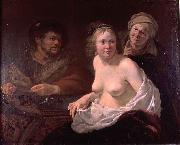 |
Jan Gerritsz. van Bronckhorst
|
|
(1603-1661) was a Dutch Golden Age painter and engraver. He is considered today to be a minor member of the Utrecht Caravaggisti group.
According to Houbraken, van Bronckhorst apprenticed as an eleven-year-old with the glass engraver Verburgh in Utrecht. He worked with him for 6 months and worked with two other Utrecht glassworkers before embarking on a Grand Tour in 1620. He did not get far before he was offered work in Arras by the glassworker Peeter Matthys. After six months, he continued on to Paris in 1620, where he worked with the glassworker Chamu. He returned to Utrecht in 1622, where Cornelis Poelenburg taught him to paint. He married Catalijntje van Noort in 1626. He frequented the studio of Gerard van Honthorst. In 1647 he moved to Amsterdam where he created the stained glass windows and the organ doors (almost the only area in a Calvinist church where figurative painting was sometimes allowed) of the Nieuwe Kerk (finished in 1655). He has been described as the last of the great stained glass painters in Holland.. Unlike his work for churches, his secular paintings show the influence of Caravaggio, and also show a striking appeal to sensuality. Among his pupils are counted his sons Jan Jansz and Gerrit Jansz, and Cesar van Everdingen. |
|
|
|
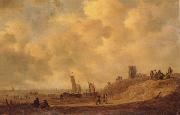 |
Jan josephsz van goyen
|
|
Dutch , Leyden 1596-The Hague 1656
was a Dutch landscape painter. Van Goyen was an extremely prolific artist; approximately twelve hundred paintings and more than one thousand drawings by him are known. Jan van Goyen was the son of a shoemaker and started as an apprentice in Leiden. Like many Dutch painters of his time, Jan van Goyen studied art in the town of Haarlem with Esaias van de Velde. At age 35, he established a permanent studio at Den Haag (The Hague). Crenshaw tells (and mentions the sources) that Van Goyen's landscape paintings rarely fetched high prices, but he made up for the modest value of individual pieces by increasing his production, painting thinly and quickly with a limited palette of inexpensive pigments. Despite his market innovations, he always sought more income, not only through related work as an art dealer and auctioneer but also by speculating in tulips and real estate. Although the latter was usually a safe avenue of investing money, in Van Goyen's experience it led to enormous debts. Paulus Potter rented one of his houses. Nicolaes van Berchem became his pupil. In 1652 and 1654 he was forced to sell his collection of paintings and graphic art, and he subsequently moved to a smaller house. He died in 1656, still unbelievably 18,000 guilders in debt, forcing his widow to sell their remaining furniture and paintings. |
|
 |
Jan van Goyen
|
|
1596-1656
Dutch
Jan van Goyen Galleries
Dutch landscape painter. He studied at Leiden and Haarlem. In 1631 he settled at The Hague. His typically Dutch landscapes of harbors, canals, riverbanks, and winter scenes with skaters and sleighs are naturalistically painted in a grayish-green tonality. He was one of the first landscape painters to sacrifice minute detail for atmospheric effect and space, and he had a considerable influence on later Dutch landscapists. His paintings are in many collections in Europe and the United States. Famous examples are Panorama of The Hague (The Hague); Banks of a Canal (Louvre); and View of Dordrecht (Rijks Mus.). The Metropolitan Museum has five of van Goyen's works, and the Pennsylvania Academy, two. |
|
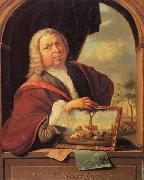 |
Jan van Gool
|
|
Johan, or Jan van Gool (1685 - 1763) was a Dutch painter and writer from The Hague, now remembered mainly as a biographer of artists from the Dutch Golden Age.
According to the RKD he learned to paint from Simon van der Does and Mattheus Terwesten. He became a member of the Confrerie Pictura in 1711. He was first regent, and then five years later became director, of the Hague Drawing School from 1720-1734. He spent most of his time in the Hague, but travelled to England twice and is recorded there in 1711. He specialized in Italianate landscapes.
He is best known today for his book of artist biographies, otherwise known as the "Nieuw Schouburg". The full title is De Nieuwe Schouburg der Nederlantsche kunstschilders en schilderessen: Waer in de Levens- en Kunstbedryven der tans levende en reets overleedene Schilders, die van Houbraken, noch eenig ander schryver, zyn aengeteekend, verhaelt worden. (The Hague, 1750). |
|
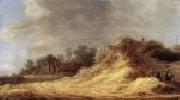 |
Jan van Goyen
|
|
Dutch Baroque Era Painter, 1596-1656
Jan van Goyen was born in Leiden on Jan. 13, 1596. Apprenticed from the age of 10, he had several masters. About 1617 he went to Haarlem to study with Esaias van de Velde, an important innovator in the Haarlem movement of realistic landscape painting. Van Goyen's works between 1621 and 1625 are sometimes hard to distinguish from those of his teacher. They are colorful, detailed views of villages and roads, usually busy with people, as in Winter (1621). It was Van Goyen's usual practice to sign or monogram and date his paintings. He traveled extensively through the Netherlands and beyond, recording his impressions in sketchbooks, occasionally with dates and often depicting recognizable scenes. Thus the chronology of his development is clear. His paintings of the late 1620s show a steady advance from the strong colors and scattered organization of his early works toward tonality and greater simplicity and unity of composition. By 1630 he was painting monochromes in golden brown or pale green; he played a leading part in the tonal phase of Dutch landscape painting. In 1631 Van Goyen settled in The Hague, where he became a citizen in 1634. The simplicity, airiness, and unification of his compositions continued to increase in his abundant production of dune landscapes, river views, seascapes, town views, and winter landscapes. The River View (1636) displays a river so open and extensive as to suggest the sea, with reflections that prolong the vast and luminous sky. In its monumentalization of humble structures and its composition built on a firm scaffolding of horizontal and vertical forces, it forecast at this early date developments that dominated landscape painting in the 1650s and later. In the Village and Dunes (1647) the traditional double-diagonal composition still exists, but it is dominated by horizontal and vertical accents. Stronger contrasts of light and dark replace the earlier tonality. In the last year of his life Van Goyen produced an eloquent new style, in which powerful forms stand out against the radiant sky and water in an exquisitely balanced composition (Evening Calm; 1656). The commission in 1651 to paint a panoramic view of The Hague for the Burgomaster's Room shows the high regard in which Van Goyen was held. He was enormously productive; well over 1,000 of his paintings still exist, and almost as many drawings. |
|
|
|
|

